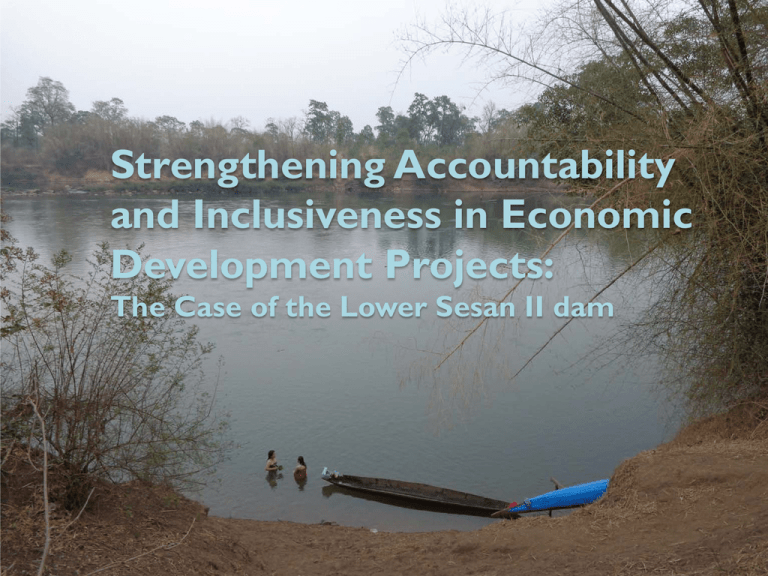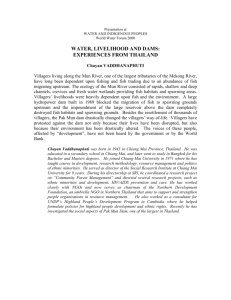Strengthening Accountability and Inclusiveness in Economic Development Projects:
advertisement

Strengthening Accountability and Inclusiveness in Economic Development Projects: The Case of the Lower Sesan II dam Background to the Research The project is funded by Oxfam Australia and Monash University The central goal of this project is to investigate existing barriers to community driven accountability, and the factors enabling some communities to develop relatively stronger community centred accountability processes than others. Examine three cases studies in different geographic locations in Cambodia. People impacted by large-scale development projects This presentation draws on findings from LSS2 case study. Introduction The ASEAN countries are increasingly looking at hydropower as the solution to power needs. Cambodian gov’t has signed the agreement for LSS2 dam project in Se San district Stung Treng province. Capacity proposed 400MW Project Developers ◦ RGC with Royal Group, Hydrolancang International Energy Co. Ltd and Electricity of Vietnam (10%) Presentation question How much has the Se San 2 dam project involved affected people in consultation and decision making processes according to the principles of Free, Prior and Informed Consent (FPIC)? Research Methods for LSS2 Fieldwork from Nov-2012 to March-2013. Target Areas: Four villages in Se San district Criteria for selection: ethnicity, geographic situation, identified strong & weak networks Semi-Structure Interview with provincial departments, district & commune authorities, NGOs, community networks, affected villagers Participatory mapping exercises: Time line, Venn Diagram, Force Field Analysis with NGOs, community networks, villagers. Secondary data review What is FPIC ? Free, Prior and Informed Consent FPIC is a right for indigenous people as stated in International law and in the UN Declaration on the Rights of Indigenous People ◦ Free: free from force, intimidation, manipulation or pressure by company or gov’t. ◦ Prior: To gov’t allocating land for particular land uses and prior to approval of specific project. Gov’t must give enough time to peoples consider all information and make decisions. ◦ Informed: Developers must give all relevant information to affected communities. ◦ Consent: Requires that the project developers allow affected peoples to say ‘yes’ or ‘no’ to each stage of the project. Findings Prior Consent ◦ The villagers living in the reservoir area were not informed prior to the decision to plan for a dam in Sesan. ◦ According to interviews, villagers heard about the dam through two main channels, both informal: Canadian Researcher Ian Baird 2008 Vietnamese surveyors in 2008 ◦ No official visits from company representatives ◦ Most information regarding the dam has been received from NGOs. Findings cont. The right to say yes or no ◦ Whether villagers have been directly asked whether they agree with the project and give their consent, yes or no, is unclear but; ◦ Villagers have expressed discontent about the dam project and stated that they did not want it to go ahead. ◦ Villagers themselves are unclear about their right to give consent to the project. ◦ Frustration that opinions are not being taken into consideration. ◦ Don’t want to be seen to oppose the ‘development’ of Cambodia. Findings cont. Free Consent ◦ Affected families have been provided with partial information and do not have a full picture to base their decisions on. ◦ Forms that families were expected to thumb print were in Vietnamese and people were unable to read. ◦ Circumstances of meetings have sometimes meant that people are encouraged to agree without being able to discuss their feelings and ideas in more detail. Findings cont. Clear Information ◦ The affected people have heard about the dam, but few have clear information on what the project involves, what the real impacts will be (+ & -) and what resettlement and compensation was being offered to them. ◦ They also had NO information on their rights as affected indigenous people to be consulted and to participate in the project planning and dialogue. ◦ The provision of information has not always been given in the language of the people ◦ Little is documented at meetings. People rely on their memory of what was said Cont. Clear Information ◦ The provision of information is also constrained by the village context. ◦ NGOs have helped to provide information to the communities. ◦ But NGOs also do not have the full information as they have not been able to meet with government and the company to discuss the issues in depth. ◦ The lack of clear information has meant that people are left guessing about their situation. This has created a high degree of stress and worry. Cont. Spaces for Community voices to be heard ◦ Affected communities have a lack of opportunity to meet with the project developers or the gov’t from national level ◦ Local authorities are still working in a subservient way to the upper authorities and have not been able to raise the communities’ concerns to the upper levels. ◦ Meetings held in Khmer result in some people not being confident to talk. ◦ Communities are relying on NGOs and sometimes the media to help them to pass the message up to higher levels of government. Conclusions Lack of clear and complete info. about dam project and resettlement. Language issues - big barrier to people having information Geography- remote area difficult to access the key decision makers of project and the media. People are not aware their right to consent and consultation. Daily livelihood limits people’s ability to participate in meetings. Local authorities lack capacity to raise concerns to upper levels (not represent of people) Lack of opportunity for dialogue make it difficult to express opinions in a free and informed way. Recommendations Need for government, company developers to respect the right of people to FPIC. ◦ Regular consultation and dialogue between developers & communities ◦ More capacity for local authorities to raise concerns to upper levels ◦ More effort to ensure meetings are clearly documented ◦ More effort to ensure meetings are in local languages ◦ More effort to ensure people feel comfortable to raise their concerns Increase use of media to share information to communities and to raise community concerns Recommendations NGOs to support communities by informing them of their rights to FPIC and by developing strategies and plans for them to use FPIC to protect their rights. ◦ Educate communities on FPIC ◦ Provide information regarding the projects that can provide an alternative view to that provided by government & developers ◦ Act as facilitator to help set up and ensure community participation in dialogue and meetings ◦ Brief communities before meetings and assist in documentation of meetings ◦ Assist community to facilitate discussion in communities so they can come up with a clear decision and strategy ◦ Help communities seek independent advice





